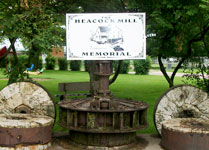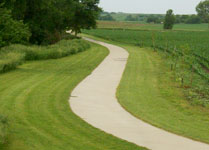
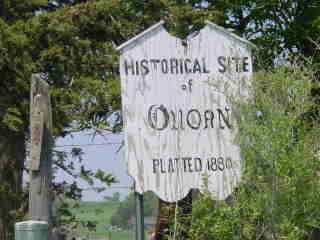 Kingsley's history actually begins with the village of Quorn, located a mile west of town. The Close Bros, wealthy Englishmen, bought up thousands of acres of farm land in this area. They conducted the affairs of the many farms they owned from their land office located in Quorn. English families sent their boys to the Close farms to learn how to farm. Tuition was $600 a year which included board and a horse. They were called "pups" by local community members. These young men were often more carefree and fun-loving rather than serious, and the program only lasted about 2 years. Quorn was platted in September, 1880. By 1882 it was a thriving town with a population of 300 to 400. Many businesses were located in Quorn, including the Heacock Mill built along the West Fork River.
Kingsley's history actually begins with the village of Quorn, located a mile west of town. The Close Bros, wealthy Englishmen, bought up thousands of acres of farm land in this area. They conducted the affairs of the many farms they owned from their land office located in Quorn. English families sent their boys to the Close farms to learn how to farm. Tuition was $600 a year which included board and a horse. They were called "pups" by local community members. These young men were often more carefree and fun-loving rather than serious, and the program only lasted about 2 years. Quorn was platted in September, 1880. By 1882 it was a thriving town with a population of 300 to 400. Many businesses were located in Quorn, including the Heacock Mill built along the West Fork River.
When John Blair brought the railroad to this area, the station was to be located east of Quorn according to the August, 1883 plat of the newly laid town of Kingsley. Blair hired Nahum Kingsley of Vermont to lay out the plat, many of our streets are named after towns in Vermont. With the coming of the railroad to Kingsley, many of the buildings and businesses from Quorn were moved to Kingsley. Kingsley was incorporated in February, 1884.
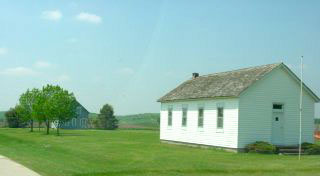
Close Bros. Land Office & 1-room country school located north of the K-P School.
Interesting Facts
Herbert Hoover's Grandmother's old house is at the corner of West 3rd & Barre, across from the Methodist Church. Herbert lived and attended school here for about 2 years.
Kingsley had a semi-pro baseball team called the Kingsley Cubs, which was funded by the American Legion from 1948 to mid 50's.
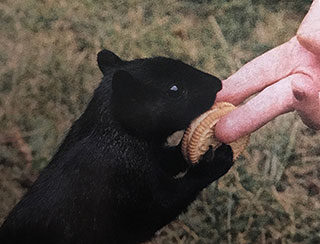 Kingsley’s Trademark - The Black Squirrels
Kingsley’s Trademark - The Black Squirrels
Kingsley is known for having black squirrels and the black squirrel has been our town trademark for many years. Black squirrels have a genetic mutation called melanism which causes them to be black. The pictured postcard (photo by Carol Phelps) is the second postcard promoting our town’s black squirrels. The first black squirrel postcard was issued for Kingsley’s Diamond Jubilee in 1959.
American Legion Nash Post #140
Kingsley’s American Legion Post #140 received its charter on August 10, 1920, and was incorporated on May 9, 1922. The officers at that time were Grant Case, Post Commander; Paul Peterson, Vice Commander; H.W. Sibley, Adjutant; and Earl Nichol, Finance Officer. There were 84 charter members, counted as service veterans at the end of World War One.
Nash Post #140’s namesake, Army Private Edward Nash, was the first local Kingsley resident killed-in-action during World War One. Edward Nash was born in Kingsley on September 13, 1894, the son of Mr. & Mrs. William Nash. Young Edward was just 22 years old when President Wilson declared war on Germany on April 2, 1917 and the United States joined the war effort which had already been raging in Europe for nearly three years. Private Nash originally enlisted in Company K out of LeMars, which was later incorporated into the Third Iowa Infantry. The troops soon transferred to Camp Mills, Hempstead, Long Island, N.Y. to prepare for deploying to France. There, the Third Iowa Infantry was consolidated with the 168th Infantry Regiment, 84th Brigade, 42nd Division. The famed “Rainbow Division,” as it became to be known, had been formed by combining National Guard units from 26 states that stretched across the country “like a rainbow” in the words of the 42nd Division’s chief of staff, Army Colonel Douglas MacArthur. Private Nash was assigned to Headquarters Company. The 168th Regiment was made up almost exclusively of Iowa troops, part of the first contingent of the National Army to leave the United States departing for France for active war service.
The vessel transporting the Iowa troops to Europe originally set sail from Long Island on October 4, 1917, but the ship encountered mechanical problems and had to return to port for repairs. It finally departed on November 14th and arrived in Liverpool, England, on December 1st. Under the command of Captain Harrison Cummins (Harry) McHenry of Des Moines, the 168th Infantry Regiment eventually reached France on December 12th and by Christmas was encamped at Rimaucourt, about 190 miles east of Paris. The Iowa Regiment hosted 400 French children at a Christmas celebration in the village of Rimaucourt. Two American soldiers dressed as Santa Claus gave presents to the French children and a French band played “The Star-Spangled Banner.” In contrast, the following week went down in the division's memory as the “Valley Forge Hike,” taking the soldiers 4 days to cover approximately 40 miles. They walked through a mountain snowstorm where the snow was 3 to 4 feet deep in places. Soldiers’ shoes wore out, some marched almost barefoot, and there were bloody trails in the snow. Shortly after that perilous journey, a fellow soldier, Private John W. Wasmer of LeMars, contracted pneumonia and subsequently died on January 20th in a hospital at Chaumont, France.
By February 21, 1918, the Iowa Regiment was positioned in front-line trenches in the Alsace-Lorraine region near Badonviller, France. Alsace-Lorraine was a territory ceded by France to Germany in 1871. Life in the trenches was challenging, to say the least. As a seasoned Yankee Doughboy described the situation, “Death was a constant companion for all who served on the line, even when no ground attacks were in progress. Shellfire, both high-explosive and gas, brought random death and injury whether men were at rest in earthwork dugout shelters, keeping watch on the fire-step, or constantly on the move between positions to maintain contact with all the platoons across the Regiment’s sub-sector. Novices to the trenches were frequent casualties since they had not yet developed the instincts to evade incoming fire and peered over the trench parapets with curiosity where enemy snipers shot at them. The trenches were also infested with vermin including rats, referred to as ‘Trench Rabbits,’ which freely scampered and fed on unburied human remains, sometimes growing to the size of a cat and spreading disease and contamination. Lice or ‘cooties’ were another endless problem which caused constant itching from their bites and movement inside clothing. Although issued Army clothing was periodically deloused in steam disinfection machines to the rear of the line, eggs embedded in the heavy seams would remain behind and hatch from body heat when the clothes were worn again for a few hours. Coughs and colds were universally suffered due to continuous exposure to unsanitary conditions combined with the cold, wet environment. Other ailments endemic to trench life included Trench Fever which was an infection and fever caused by lice infestation, Trench Foot which was a fungal infection of the feet, and Trench Mouth which consisted of bleeding gums and foul breath due to poor oral hygiene, malnutrition, and smoking. The rancid, overwhelming smell was another environmental condition that affected both the health and the mindset of the troops on the line, though all gradually acclimated to it. The smell of death and decay was pervasive from rotting corpses that lay unburied or in shallow graves which were unearthed by shellfire and the digging of new trenches. Latrines overflowed and their contents were carried by hand through the trenches in buckets which were frequently spilled and sloshed under fire. The men themselves stank from not having washed or changed clothes for weeks, with rotting feet and teeming with lice. Added to all this were the smells of explosives, gun smoke, poison gas, rotting sandbags, mud, tobacco smoke and food cooking on trench stoves.”
The 168th Infantry Regiment was the first to take control over the Baccarat sector from the French Army. There were only 85,000 U.S. troops in France when the Germans launched their last great offensive of the war in March of 1918. Private Nash was a member of Company B’s Stokes Mortar Platoon, assigned to manning Gun (mortar) Number One. The Stokes mortar was capable of launching a 3.2 inch diameter mortar projectile. Each round contained one kilogram of amatol explosive and had an effective firing range of about 750 yards.
At 4:30 AM on Tuesday morning, March 5, 1918, the Germans first opened up a box barrage raid on American lines, dropping shells on all four sides of the 168th Infantry Regiment’s position. The barrage was designed to cut the position off from supporting units and sever its lines of communication. As the Gun Number One platoon rushed out to man their Stokes mortar emplacement, the shell from a 210 millimeter German howitzer landed and exploded near the base of their mortar, killing all seven members of the Company B mortar crew instantly: Private Edward Nash of Kingsley; Private Albert E Hoschler of Akron; Private Clifford C. Worden of Mason City; Private Glenn Pederson of Spencer; Sergeant Walter J. Porsch of Fort Dodge; Sergeant James E. Wedding of Webster City; and Corporal Dean Parish of Glade Valley, NC. Also killed during the bombardment was Captain McHenry, who had left his command position to order the launch of a rocket to signal a more general barrage. The bodies of Nash, Porsch, and Worden were blown entirely to pieces, with no identifiable parts ever recovered. As the three were eulogized, “Although there is no place that says, ‘Here lies the bodies of Nash, Porsch, and Worden,’ yet we know that all these men, the pride of the platoon, were at their places with their faces toward the enemy in the first defensive combat of the regiment.”
The result of that enemy engagement was 19 soldiers lost their lives, all except two were from Iowa, plus an additional 38 were wounded. Five others killed that morning included: Private Isaac Davis of Woodburn, Private Guy O. Worley of Exline, Private Byron Van Raden of Lanesboro, Alva F. Eaton of Humeston, and Corporal Donald H. MacRae of Des Moines. Six other soldiers succumbed to serious injuries sustained soon after the battle: Private Robert L. Clausen of Mason City, Private Merrill B. Morrison of Unionville, Private Ira J. Rogers of Unionville, Private William T. Smith of Northwood, Private Ray C. Walden of Centerville, and Private Mufford R. Breese of Washington PA. The roar of the bombardment had shaken the earth for one hour and thirty-three minutes before the German attack was repulsed. Three different platoons were given citations by the French Corps and awarded the Croix deGuerre (Cross of War) for heroism.
Two days after the attack, two trucks transporting the remains of the dead were escorted through the streets of Baccarat by American and French soldiers and wound their way to up to a little cemetery outside the city. French General Segonne, Commander of the 128th Division, delivered this address: “It is with deep emotion that in the name of your comrades of the French Army, I come today to honor the remains of Captain McHenry and of the brave American soldiers who died gloriously at the hands of the enemy on the night of the 5th of March, when they were defending with tenacity and energy the labors which had been entrusted to them. The conduct of the American troops since their entry into the sector of Baccarat, their strength under fire, their ardor in the conflict, is, in every respect worthy of praise. It is in memory of Captain McHenry, it is in memory of the deceased of the American regiments of Infantry and Artillery, these men I intend to glorify. The noble American blood that has just flowed in the ancient territory of Lorraine, the time-honored battlefield, is a stronger tie between our two armies. In the folds of the American and French flags flow the same ideals of justice, loyalty, of liberty and of victory. The sacrifice generates immortality. The shade of these two flags will be soft to the departed heroes. Captain McHenry, American soldiers, sleep in peace; the grand sleep of glory; you will not be forgotten and you will be avenged.”
After eight more months of savage fighting in Europe, an armistice with Germany was signed. Though the United States involvement in World War One lasted only about 19 month, our country lost 116,516 soldiers. Of the 114,242 Iowans who served in the war, 3,576 gave their lives. At 11 am on November 11, 1918 (the eleventh hour of the eleventh day of the eleventh month) the ceasefire went into effect ending World War One. Today Veterans Day is celebrated on that date to commemorate the sacrifices and contributions of all armed forces veterans who selflessly performed their patriotic duty in defense of our country. Less than one year after the end of World War One, the American Legon was founded on March 15, 1919.
The history of the Army’s 168th Infantry Regiment and its fallen heroes during World War One has had a profound impact on many Iowa military service organizations. Kingsley’s American Legion Nash Post #140 was named in honor of Private Edward Nash. Akron’s Hoschler Post #186 was named in honor of Private Albert E. Hoschler. Mason City’s Clausen-Worden Post #101 was named in honor of two other casualties of the battle, Private Robert L. Clausen and Private Clifford C. Worden. Spencer’s Glen Pederson Post #1 honors the memory of another hero lost on March 5, 1918. LeMars’ Wasmer Post #241 was named in honor of the 168th Regiment war casualty, Private John W. Wasmer. Fallen hero Sergeant Walter Porsch was born in LeMars but had since relocated to Fort Dodge, though several of his relatives remained in the LeMars area. Sergeant Porsch’s body was never recovered, and he was memorialized at St. Mihiel American Cemetery in France. VFW Post #1856 in Fort Dodge was named in his honor. We owe a huge debt of gratitude to these and all fallen brothers- & sisters-in-arms that can never be fully repaid. It is fitting that we acknowledge our noble heritage and honor the selfless service of all veterans who paid the ultimate sacrifice for our freedom, the last full measure of devotion.


